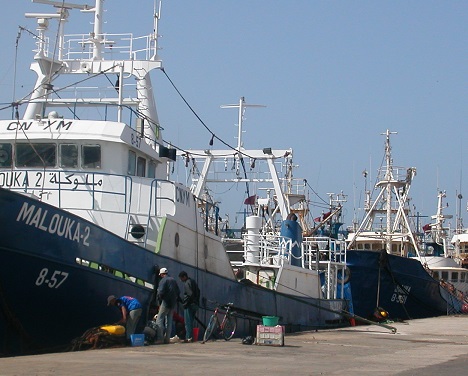VMS or AIS for Sustainable Fisheries Management?
- 3 July 2020
- Category: Articles, News

There has been discussion across the industry about adapting AIS for fisheries monitoring. Increasingly AIS is seen as a transparent and freely available tool and as a result fishermen and companies are questioning why they should have a separate VMS.
However, I believe that substituting AIS for VMS is to clearly misunderstand the functions of each system. To a certain extent the clue is in the name. AIS stands for Automatic Identification System, while VMS stands for Vessel Monitoring System, and each system was developed for a different purpose.
VMS was developed in the 1990s for vessel monitoring, control and surveillance. The system was to address key concerns facing both fishing vessels and the regulatory authorities, such as national sovereignty issues with boats fishing in another nation’s territorial waters, combating illegal fishing and sustainably monitoring marine resources. It was designed to deliver accurate, regular positions of vessels without any regional or global limits. At that time CLS – through our Argos global satellite system – could locate any vessel anywhere in the world. We worked with international fisheries and industry groups, governments and regional fisheries management organisations (RFMOs) to develop the VMS concept.
This collaboration with flag states (the European Commission for EU states) and the industry involved a lengthy process that included pilot projects and competitive benchmarks. Ensuring that vessels’ positions would be received in all conditions and guaranteeing position delivery to the flag state were a must. The resulting VMS system transmits encrypted data between the vessel transponder and the satellite, the system operator, and the flag state and coastal states, securely and almost instantly.
VMS is designed so that the flag states are the only ones empowered to receive, validate and distribute VMS data to whoever needs to know (RFMOs, coastal states, etc). The fishing companies can then be confident that the privacy of their data is protected by their national authority. The information can’t be hacked by an unauthorized operator, protecting the vessel’s market-sensitive information.
VMS Today
Nearly three decades on, VMS technology has developed even further. It is still securely encrypted, and the data transfer is still certified, but as requirements increased (more frequent positions, up to every 15 minutes in some countries), VMS evolved to work with other systems such as Iridium, offering two-way transmission. This opened a whole range of possibilities, such as sending weather reports or storm alerts, and the introduction of electronic catch reports. In the last 10 years, more countries have developed customized logbooks designed to be sent through a VMS device to ensure the same levels of data delivery and protection as the position reports. The fishermen can now report their catch and their observations instantly (by-catch, protected species), allowing more responsive catch management. This catch traceability through secure data transmission also ensures fishermen’s’ compliance and their access to high value markets, acting as a ‘visa’ for the fish to be landed in port. In Europe, vessels will soon need to record and land any bycatch, and again VMS monitoring will help ease and support this process.
Over time, VMS has proved to be a valuable tool in the fight against illegal fishing and now it is the only reporting system recognised by the United Nations’ Fisheries Agriculture Organization (FAO) for the global monitoring of fisheries.
What is AIS?
From the beginning, CLS has also worked with this technology for our maritime shipping customers. Starting in the 2000s, AIS was set as the standard for vessels subject to SOLAS (International Convention for Safety of Life At Sea) by the International Maritime Organization. Initially, AIS signals were received through coastal networks of land stations. Designed to be a collision avoidance system, not a global ship tracking system, AIS has undoubtedly saved lives at sea by improving the safety of navigation. AIS is not mandatory on smaller ships but many are using it simply because of its safety benefits. When it’s turned on, it highlights the vessel’s location to any other vessel nearby and shows the routes those vessels are taking and reduces potential collision risks.
In recent years, private companies have developed satellites able to receive AIS (SAT-AIS) messages and thereby extend the range. This has led to a certain confusion with VMS, leading some to think AIS can be used for fisheries management.
Why not AIS for Fisheries?
AIS was developed to show where any vessel was, to avoid collisions; it was never intended to support fisheries monitoring. VMS is better suited for fisheries management for two main reasons: 1) It can support larger data transfers, thereby opening the way for other added services such as e-logbooks as described above; and 2) VMS preserves a flag state’s sovereignty over its waters and resources because it is a secure system guaranteeing data delivery.
AIS data, however, is openly available, and this makes sense because the goal is to avoid collisions. The data is sent via VHF which can be accessed by anyone with an AIS receiver, potentially revealing a vessel’s prime fishing grounds to its competitors. The data can also be recovered by militant groups, pirates, internet companies, any one at all. This is completely different from VMS, where the flag states control and protect the data, and decide when and with whom to share it.
It’s not secure either, as an AIS system can be hacked into and the data altered. It can also be turned off, a function useful for ships in high risk piracy areas, but that means it’s no use for fighting illegal fishing, as a fishing vessel operating illegally may do exactly the same.
Finally, the sheer volume of AIS data can lead to problems collecting, processing and downloading all the messages. In areas of medium to high density shipping, research has shown that satellite-AIS receivers actually receive only a small percentage of the messages transmitted. In particular, AIS Class B transmitters (those found on smaller boats) are often masked to satellites by high AIS traffic.
In sum, if a monitoring system does not fulfil essential requirements like data security, the ability to evolve with new e-logbook requirements, and continuity of operations in all sea states and in all areas, then it can’t meet the basic needs of sustainable fisheries management. AIS and VMS are both useful systems that meet different needs: we can think of AIS as improving safety for sailors and vessels, and VMS as a passport for fishermen to prove their catch is compliant with conservation measures.
As governments and RFMOs work to monitor the oceans and the blue economy, and to achieve sustainable fish stocks, only VMS can deliver the enhanced monitoring and surveillance demanded worldwide, while providing fishermen with the certainty they meet fisheries regulations.
 Jean-Pierre Cauzac, Head of Strategic Projects, Sustainable Fisheries Division, CLS Group
Jean-Pierre Cauzac, Head of Strategic Projects, Sustainable Fisheries Division, CLS Group
After master’s degrees in electrical engineering and business, Jean-Pierre joined CLS in 1991 just as the company was developing the first global satellite tracking system. Over his career, he has worked with vessel tracking systems for maritime security, vessel monitoring systems for fisheries, catch management, and detection of illegal fishing vessels, with a front row seat to all the changes in VMS and AIS technology and regulations. CLS’ Fisheries Division provides sustainable fisheries management solutions to clients in over 90 countries. This article first appeared in World Fishing & Aquaculture, December, 2019
